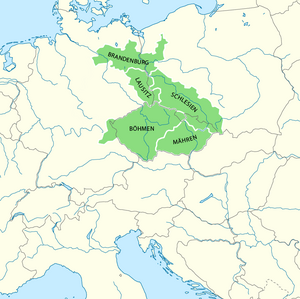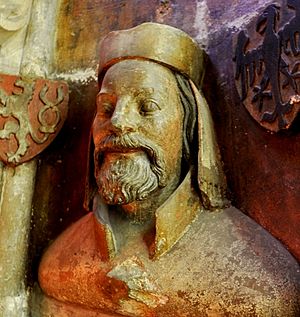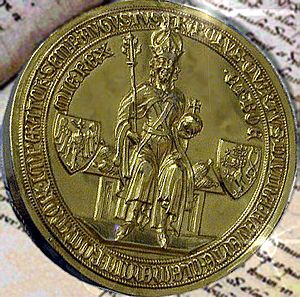Charles IV, Holy Roman Emperor facts for kids
Quick facts for kids Charles IV |
|
|---|---|
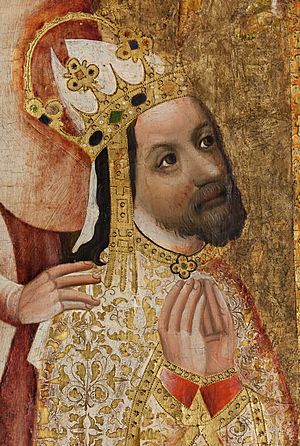 |
|
| King of Bohemia | |
| Reign | 26 August 1346 – 29 November 1378 |
| Coronation | 2 September 1347, Prague |
| Predecessor | John |
| Successor | Wenceslaus IV |
| King of the Romans | |
| Reign | 11 July 1346 – 29 November 1378 |
| Coronation | 26 November 1346, Bonn |
| Predecessor | Louis IV |
| Successor | Wenceslaus IV |
| Holy Roman Emperor, King of Italy | |
| Reign | 1355 – 29 November 1378 |
| Coronation | |
| Predecessor | Louis IV |
| Successor | Sigismund |
| Born | 14 May 1316 Prague |
| Died | 29 November 1378 (aged 62) Prague |
| Burial | St. Vitus Cathedral, Prague |
| Spouse |
|
| Issue |
|
| House | Luxembourg |
| Father | John of Bohemia |
| Mother | Elisabeth of Bohemia |
| Religion | Roman Catholicism |
Charles IV (born Wenceslaus) was a very important ruler in Europe. He was born on May 14, 1316, and died on November 29, 1378. He was the first King of Bohemia to also become the Holy Roman Emperor.
Charles was part of the House of Luxembourg through his father, John of Bohemia. His mother, Elisabeth of Bohemia, came from the Czech House of Přemyslid. Charles really loved his Czech heritage. Two saints were even in his mother's family!
His father, King John, died in a famous battle called the Battle of Crécy in 1346. After his father's death, Charles became the King of Bohemia. He was crowned in Prague on September 2, 1347.
Before that, in 1346, some important leaders called prince-electors chose Charles to be the King of the Romans. This was a big deal because he was chosen against the current emperor, Emperor Louis IV. Charles was crowned King of the Romans in Bonn on November 26, 1346.
When Emperor Louis IV died, Charles was chosen again in 1349. In 1355, he was crowned King of Italy and then the Holy Roman Emperor. By 1365, he was also crowned King of Burgundy. This meant he ruled all the kingdoms of the Holy Roman Empire.
Contents
Life of Charles IV
Charles IV was born in Prague. His parents were King John and Queen Elizabeth. He was first named Wenceslaus, after his grandfather. Later, he changed his name to Charles when he was confirmed. He chose the name to honor his uncle, Charles IV of France. Charles lived at his uncle's court in France for seven years.
He got a French education and was very smart. He could read and speak five languages! These were Latin, Czech, German, French, and Italian. In 1331, he learned about warfare in Italy with his father.
In 1333, Charles went to Lucca in Italy to take control there. He even built a fortress and a town called Montecarlo (which means "Charles' Mountain") to protect the city. From 1333, he managed the lands of the Bohemian Crown. He did this because his father was often away and was losing his eyesight. In 1334, Charles became the Margrave of Moravia, a title for the heir to the throne.
Becoming King of the Romans
On July 11, 1346, Charles was chosen as the Roman king. This happened because his father and Pope Clement VI were allies. Pope Clement VI was a strong enemy of Emperor Louis IV. So, some of the prince-electors chose Charles to be king instead of Louis.
Charles had promised to obey the Pope. In 1347, he made many promises to the Pope. He agreed to give the Pope control over large areas of land. He also promised to undo Louis's actions against the Pope. Charles said he would not get involved in Italian politics. He also promised to protect the church.
At first, Charles was not very strong in Germany. People even made fun of him, calling him a "Priests' King." Many bishops and most of the Imperial cities stayed loyal to Louis IV. Things got worse when his father died at the Battle of Crécy in August 1346. Charles himself was wounded but escaped.
Luckily, a civil war in Germany was avoided. Louis IV died on October 11, 1347, after a stroke. In 1349, some people tried to elect a new king, but he didn't get much support and died soon after. After this, Charles had no one directly challenging his claim to the throne.
Charles worked hard to make his power strong. The terrible Black Death plague did not affect Bohemia much. Charles made Prague his capital city. He rebuilt Prague to be like Paris, even creating the New Town. In 1348, he started the Charles University in Prague. This was the first university in Central Europe and was named after him. It helped train smart people for his government. Soon, Prague became a very important center for learning and culture in Central Europe.
Charles used his opponents' problems to his advantage. He was elected king again in Frankfurt in 1349. He was crowned again in Aachen on July 25, 1349. Soon, everyone agreed he was the true ruler of the Empire. He gained support from towns by giving them gifts or making promises. He also made friends with the Habsburg family through marriage. He married Anna, the daughter of Rudolf II, Duke of Bavaria, after his first wife died in 1348.
In 1350, a Roman leader named Cola di Rienzo visited Charles in Prague. He wanted Charles to go to Italy. The poet Petrarch and the people of Florence also asked him to come. But Charles didn't go. He kept Cola in prison for a year. Then he sent him to the Pope.
Charles also tried to make the Bohemian lands bigger. He used his power as emperor to get more lands in Silesia, the Upper Palatinate, and Franconia. These new areas were called "New Bohemia." They were meant to connect Bohemia with his family's lands in the Rhineland. However, the Bohemian people didn't want to support these plans. When Charles tried to write down Bohemian laws in 1355, they strongly resisted. After that, Charles decided to slow down his plans for centralizing power.
Becoming Holy Roman Emperor
In 1354, Charles traveled across the Alps mountains without an army. He received the Lombard crown in Milan on January 5, 1355. Then, he was crowned emperor in Rome by a cardinal in April of that year. His main goal was to get the Imperial crown peacefully, as he had promised the Pope. He only stayed in Rome for a few hours, even though the Roman people wanted him to stay longer. He gave up most of his Imperial rights in Italy. Then, he went back over the Alps, carrying a lot of wealth. The poet Petrarch criticized him for leaving Italy so quickly.
When he returned, Charles focused on running the Empire. It was just recovering from the Black Death. In 1356, he created the famous Golden Bull. This important document set the rules for how the king of the Romans would be elected. These rules lasted for the next 400 years!
Charles gave Moravia to his brother, John Henry. He also made the county of Luxembourg into a duchy for his other brother, Wenceslaus. He worked tirelessly to get more lands and make the Bohemian monarchy stronger. He bought part of the Palatinate of the Rhine in 1353. In 1367, he added Lower Lusatia to Bohemia. He also bought many other lands across Germany.
When Meinhard, Duke of Upper Bavaria and Count of Tyrol died in 1363, his lands were claimed by others. Charles made agreements that if these families died out, the lands would go to his family, the House of Luxembourg. Around the same time, he was promised the Margravate of Brandenburg. He got this land for his son Wenceslaus in 1373.
Some other rulers, like Casimir III of Poland and Louis I of Hungary, plotted against Charles. They convinced Otto V of Bavaria to join them. But Charles declared war and invaded Brandenburg in 1371. After two years, the Margraviate of Brandenburg became part of the Czech lands in 1373. He also gained a lot of Silesian land. Some of this was through his third wife, Anna von Schweidnitz.
In 1365, Charles visited Pope Urban V and helped him travel to Rome. On the same trip, Charles was crowned King of Burgundy. His second trip to Italy was in 1368. He met Pope Urban V and was even surrounded in his palace in Siena. He left Italy before the end of 1369.
In his later years, Charles didn't get involved much in German politics. He focused on making sure his son Wenceslaus was elected King of the Romans in 1376. He also helped make peace between cities and nobles in 1378. Charles divided his lands among his three sons and nephews. He died in November 1378 in Prague. He was buried there, and a statue was put up in his honor in 1848.
Charles IV suffered from gout, a painful joint disease common at that time.
Charles IV's Legacy
Charles IV's time as ruler was a special period for the Empire. It's often called the Golden Age of Bohemia. He created the Golden Bull of 1356, which set clear rules for choosing the emperor. These rules were followed for the next four centuries!
He also organized the states of the empire into groups to keep the peace. Important Imperial Cities were a big part of these groups. For example, the Swabian Landfriede group in 1370 was almost all Imperial Cities. Charles and his helpers led these groups. The cities in these groups were given special rights to help them keep the peace.
He made sure his family had control over the eastern parts of the Empire. He did this through agreements with the Habsburgs and by buying Brandenburg. He also claimed power over the crusader states of Prussia and Livonia.
Supporting Culture and Arts
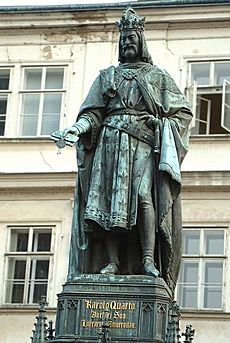
Prague became the capital of the Holy Roman Empire when Charles IV was in charge. Many famous places and buildings in Prague are still named after him. These include Charles University, Charles Bridge, and Charles Square. The beautiful High Gothic Prague Castle and parts of the cathedral of Saint Vitus were also built during his reign. He also encouraged beautiful manuscript painting in Prague. In the Czech Republic today, people still call him Pater Patriae (which means "father of the country").
Charles also had strong ties to Nuremberg. He visited the city 52 times, which made it very important among German cities. Charles supported the building of the Nuremberg Frauenkirche. This church was built between 1352 and 1362, and the famous architect Peter Parler likely designed it. The imperial court worshipped there when they visited Nuremberg.
Charles focused on making his family's power stronger. He gave the Duchy of Luxembourg to his half-brother, Wenceslaus, in 1353. He put most of his energy into making Bohemia stronger and smarter. He founded the university in 1348 and supported early humanists. He even wrote letters to the poet Petrarch. Petrarch wanted Charles to move his home to Rome and bring back the old traditions of the Roman Empire, but Charles didn't.
Charles's sister, Bona, married the son of Philip VI of France in 1335. This son later became John II of France. So, Charles was the uncle of Charles V of France. Charles V asked his uncle for advice in 1356 during a revolt in Paris. This family connection was celebrated when Charles visited his nephew in 1378, just a few months before he died. A detailed story of this visit, with many amazing pictures, can be found in a book called the Grandes Chroniques de France.
Family and Children
Charles IV was married four times.
His first wife was Blanche of Valois (1316–1348). She was the daughter of Charles of Valois. They had three children:
- A son, born in 1334, who died young.
- Margaret of Bohemia (1335–1349), who married Louis I of Hungary.
- Catherine of Bohemia (1342–1395), who married two dukes.
His second wife was Anna of Bavaria (1329–1353). She was the daughter of Rudolf II, Duke of Bavaria. They had one son:
- Wenceslaus (1350–1351).
His third wife was Anna von Schweidnitz (1339–1362). She was the daughter of Henry II, Duke of Świdnica. They had three children:
- Elisabeth of Bohemia (1358–1373), who married Albert III of Austria.
- Wenceslaus (1361–1419). He later became King of Germany and King of Bohemia (as Wenceslaus IV). He married twice.
- A son, born and died on July 11, 1362.
His fourth wife was Elizabeth of Pomerania (1345 or 1347–1393). She was the daughter of Duke Bogislaw V, Duke of Pomerania. They had six children:
- Anne of Bohemia (1366–1394), who married Richard II of England.
- Sigismund (1368–1437). He later became Holy Roman Emperor, King of Hungary and Bohemia. He married twice.
- John of Görlitz (1370–1396). He became Margrave of Moravia and Duke of Görlitz.
- Charles (1372–1373).
- Margaret of Bohemia (1373–1410), who married John III, Burgrave of Nuremberg.
- Henry (1377–1378).
Castles Built by Charles IV
Charles IV built or helped establish several castles:
- Karlstein Castle, built from 1348–1355 in the Central Bohemian Region. It was used to keep important treasures like the Imperial Crown of the Holy Roman Empire.
- Kašperk Castle (Karlsberg), built in 1356 in the Klatovy District.
- Lauf (Wenzelsburg) – built on the road between Prague and Nuremberg. It has 112 coats of arms from the Czech Kingdom inside.
- Montecarlo in Italy.
- Radyně (Karlskrone) – built around 1360 in the Plzeň Region.
- Hrádek u Purkarce (Karlshaus) - built around 1357.
- Tepenec (Twingenberg, Karlsburg).
- Karlsfried Castle.
Places Named After Charles IV
Many places are named after this important ruler:
- Karlštejn castle, Czech Republic.
- Karlštejn (town), Czech Republic.
- Charles Bridge, Prague (Karlův most).
- Charles University, Prague (Karlova Universita).
- Karlovy Vary spa, Czech Republic.
- Charles Square, Prague (Karlovo náměstí).
- Montecarlo (Charles' Mountain) fort and village in Italy.
- 16951 Carolus Quartus (an asteroid).
Images for kids
-
Meeting with Charles V of France in Paris in 1378.
See also
 In Spanish: Carlos IV del Sacro Imperio Romano Germánico para niños
In Spanish: Carlos IV del Sacro Imperio Romano Germánico para niños


